Raccoons
Raccoons are nocturnal, omnivorous, and have a reputation for mischievousness. They are particularly noted for their thumbs which, while not opposable as are a human’s, provide them with considerable dexterity in manipulating food (or opening garbage cans).
It seems likely that raccoons are a relatively recent species around the Lake. Old newspapers reveal that early settlers constantly complained about skunks, but raccoons were never mentioned. This is substantiated by the 1897 Yearbook of British Columbia (editor: R.E. Gosnell) in which the curator of the Provincial Museum, a Mr. Fannin, wrote that, “Raccoons are abundant west of the Cascades [Coast Mountains] including Vancouver Island and the larger islands.” By way of contrast, he notes that skunks are abundant across the province. This century–old description seems to have been the source of an anachronistic range map in the modern book, Mammals of British Columbia, (by Eder & Pattie, 2001).
But, when did raccoons reach this area? Well, good local observers with long memories cannot recall seeing any raccoons around Nelson in the 1930s and 40s. Yet, by the 1950s raccoons were observed in the extreme southern interior: Okanagan Falls, Wynndel and Wardner (Mammals of BC by Dr. Ian McTaggart Cowan and Charles Guiguet, 1951). So, they were at the south end of the Main Lake by then, but present evidence suggests that they may not have been around Nelson until maybe the 1970s. Johnsons Landing has had them since the mid–1990s which is earlier than the Kaslo date of about 2001. This suggests they came along the East Shore rather than the largely impassible west shore. As for the West Arm, I have seen them at various places between the bridge and Balfour.
From a look at the pictures, below, one might suspect that the area is awash with the animal; yet, I hardly knew that raccoons were even present until I began taking pictures at night. It seems that although historically absent, Raccoons have now extended their range around much of the Lake.
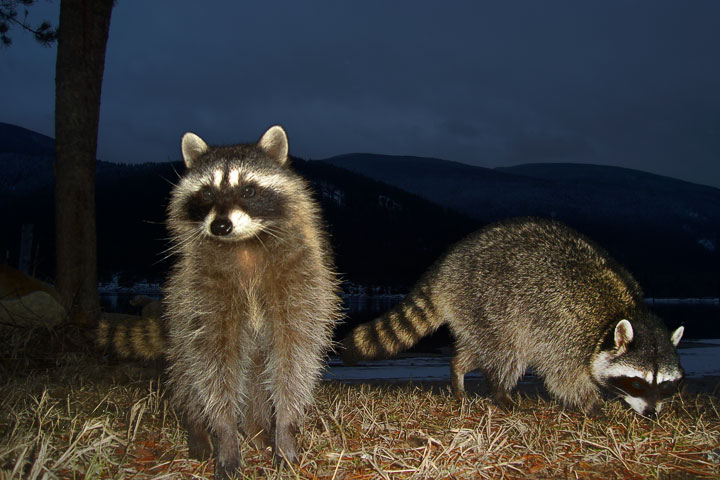 With the coming of evening, Raccoons forage along the Lakeshore. Raccoons are active year round; this is mid March.
With the coming of evening, Raccoons forage along the Lakeshore. Raccoons are active year round; this is mid March.
 This view, captured from nearly the same spot as the one above, is from early December.
This view, captured from nearly the same spot as the one above, is from early December.
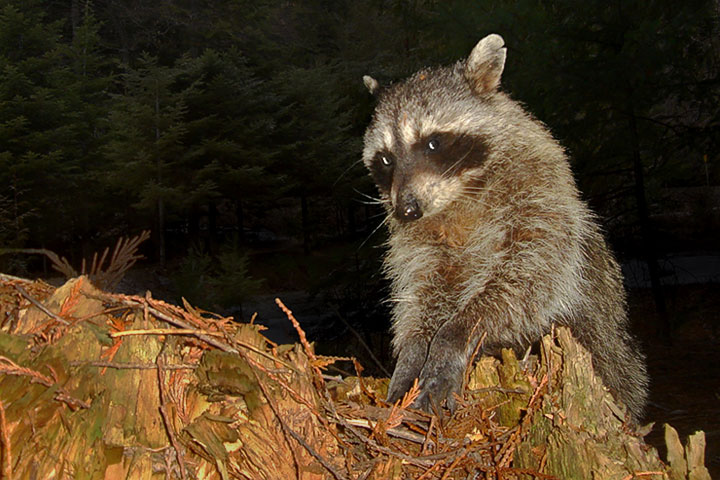 Raccoons are not known to be coquettish—but, then…
Raccoons are not known to be coquettish—but, then…
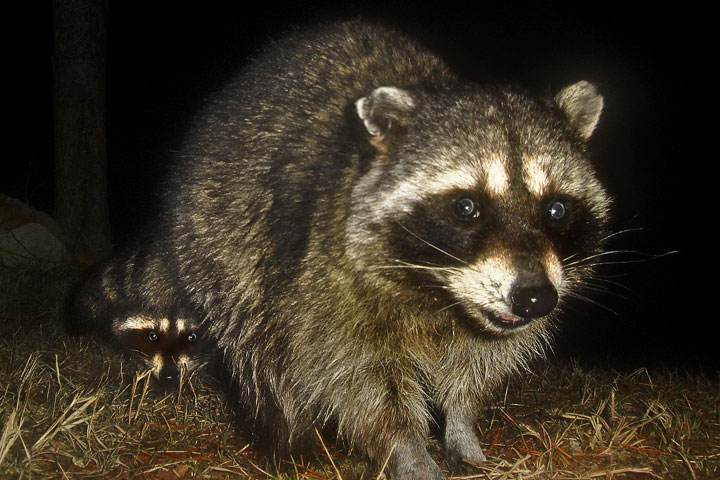 One could be forgiven for thinking Raccoons are hams in front of the camera.
One could be forgiven for thinking Raccoons are hams in front of the camera.
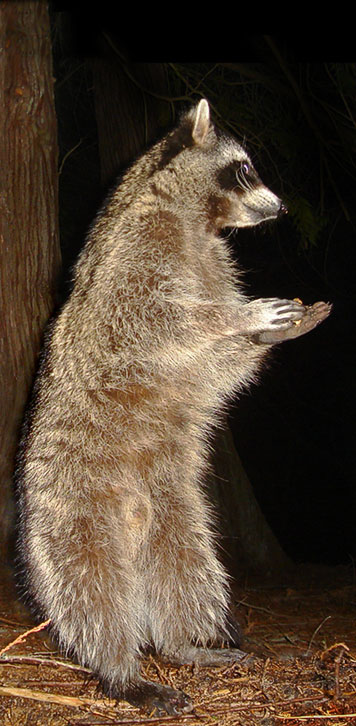 The dexterity of the Raccoon’s forepaws is great; there are few other animals in BC which one could imagine standing up and handling their food in this manner.
The dexterity of the Raccoon’s forepaws is great; there are few other animals in BC which one could imagine standing up and handling their food in this manner.
 Raccoons are known to take a curious interest in shiny objects; this fellow had been foraging along the lakeshore in the evening and seems to have found the camera worthy of a closer look.
Raccoons are known to take a curious interest in shiny objects; this fellow had been foraging along the lakeshore in the evening and seems to have found the camera worthy of a closer look.
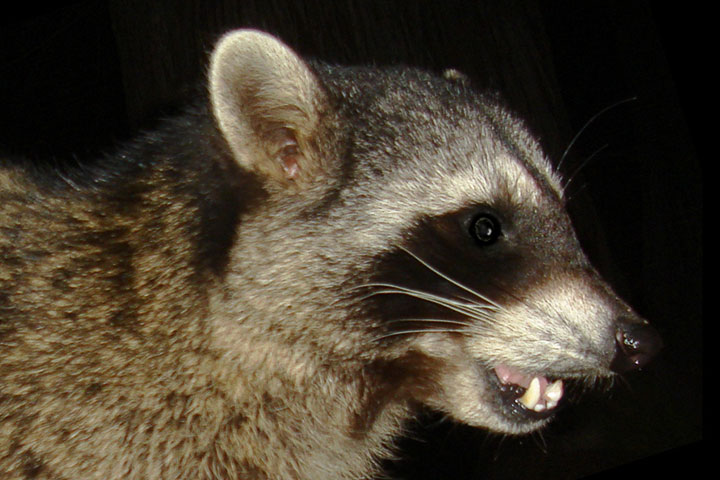 The raccoon’s canine teeth are impressive.
The raccoon’s canine teeth are impressive.
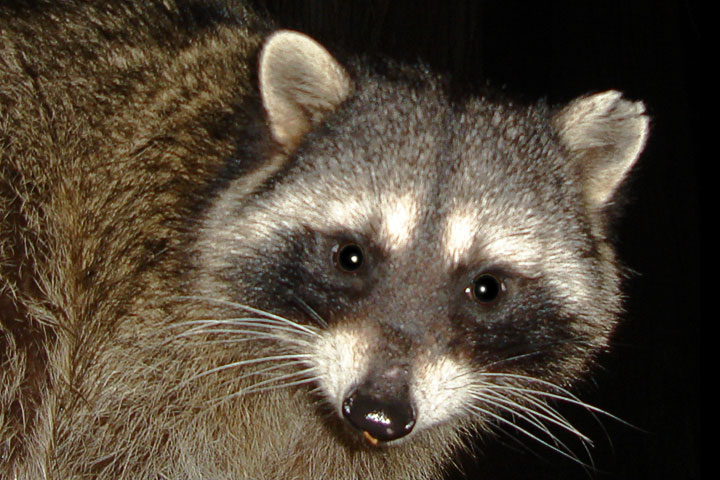 This raccoon, with the damaged ear, has become a frequent visitor. The spacing of those marks seems to be about the same as spacing of a raccoon’s canine teeth.
This raccoon, with the damaged ear, has become a frequent visitor. The spacing of those marks seems to be about the same as spacing of a raccoon’s canine teeth.
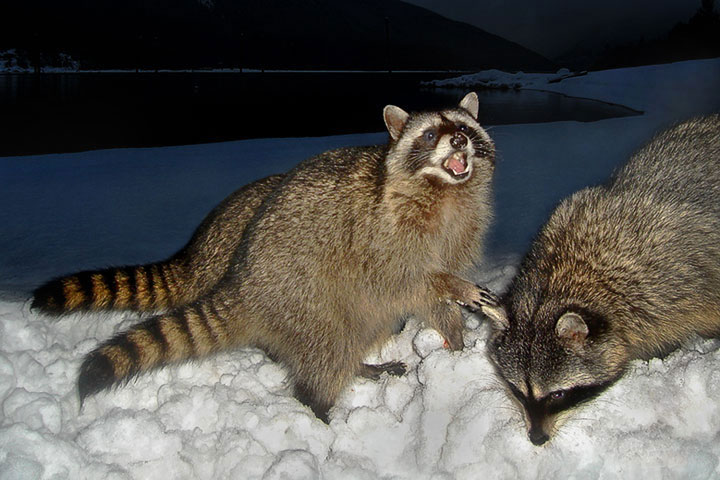 I assume that the raccoon in this early February, lakeside, view is reacting to a perceived danger. Raccoons are very vocal and have over fifty different calls, one of which, a tremulous whoo-oo-oo-oo, sounds rather like some owls. Quarreling raccoons sound like angry cats.
I assume that the raccoon in this early February, lakeside, view is reacting to a perceived danger. Raccoons are very vocal and have over fifty different calls, one of which, a tremulous whoo-oo-oo-oo, sounds rather like some owls. Quarreling raccoons sound like angry cats.
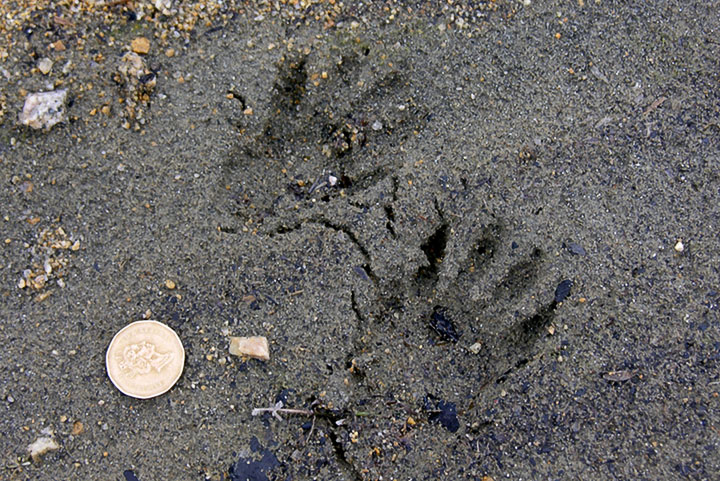 Raccoons are frequently found near water where one of them has left its tracks in the mud, clearly showing five toes. Actually mud is not common along the lakeshore which is more characteristically sand or pebbles. But, when the Lake is low in March and April, the exposed mud provides a slate upon which the raccoon leaves its mark.
Raccoons are frequently found near water where one of them has left its tracks in the mud, clearly showing five toes. Actually mud is not common along the lakeshore which is more characteristically sand or pebbles. But, when the Lake is low in March and April, the exposed mud provides a slate upon which the raccoon leaves its mark.
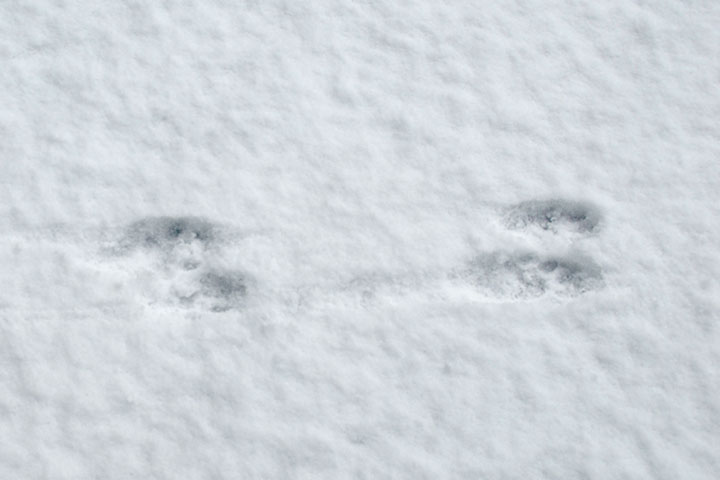 These tracks were made when a Raccoon travelled from left to right. Raccoons have a walking pattern which differs from every other animal; each pair of prints shows one forepaw and one hindpaw. In the picture, the left pair shows the left hindpaw (top) and right forepaw (bottom), while the right pair show the left forepaw (top) and right hindpaw (bottom). This is one of the raccoon’s three distinct walking gaits.
These tracks were made when a Raccoon travelled from left to right. Raccoons have a walking pattern which differs from every other animal; each pair of prints shows one forepaw and one hindpaw. In the picture, the left pair shows the left hindpaw (top) and right forepaw (bottom), while the right pair show the left forepaw (top) and right hindpaw (bottom). This is one of the raccoon’s three distinct walking gaits.
 An encounter such as this between nocturnal animals must be fairly common. It is less common to capture an image of it. In this warm summer’s evening meeting between a white-tailed doe and a raccoon, it was the raccoon which withdrew.
An encounter such as this between nocturnal animals must be fairly common. It is less common to capture an image of it. In this warm summer’s evening meeting between a white-tailed doe and a raccoon, it was the raccoon which withdrew.
 I cannot tell one raccoon from another—unless there has been an injury. Scraps between raccoons often leave damaged ears. The nick on the tip of the right ear enables this raccoon to be identified as the same animal as that in the picture below, but a different animal than than the scratching raccoon in the picture to the right: it has a larger nick in its left ear.
I cannot tell one raccoon from another—unless there has been an injury. Scraps between raccoons often leave damaged ears. The nick on the tip of the right ear enables this raccoon to be identified as the same animal as that in the picture below, but a different animal than than the scratching raccoon in the picture to the right: it has a larger nick in its left ear.
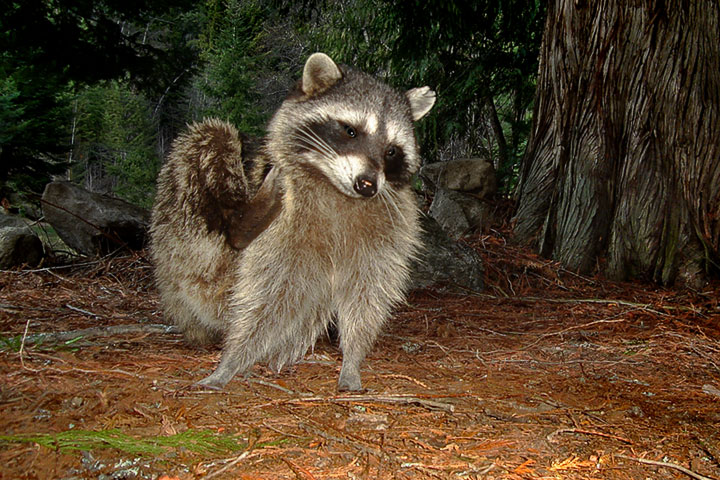 Sometimes one just has to pause for a moment and have a good scratch.
Sometimes one just has to pause for a moment and have a good scratch.
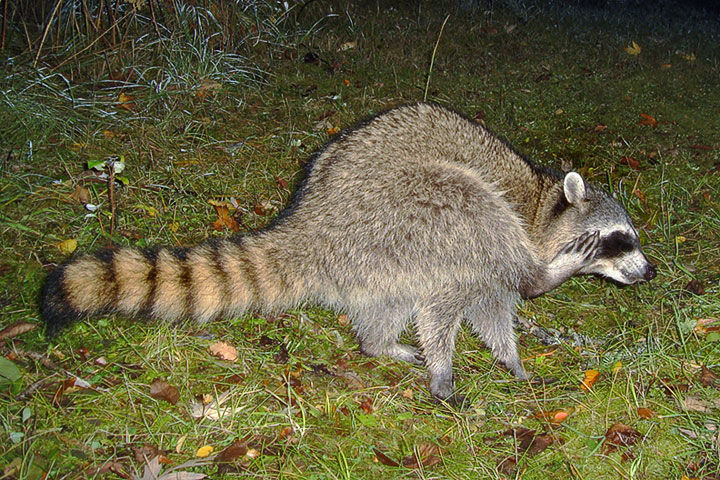 Sometimes one just has to pause for a moment and have a good scratch.
Sometimes one just has to pause for a moment and have a good scratch.
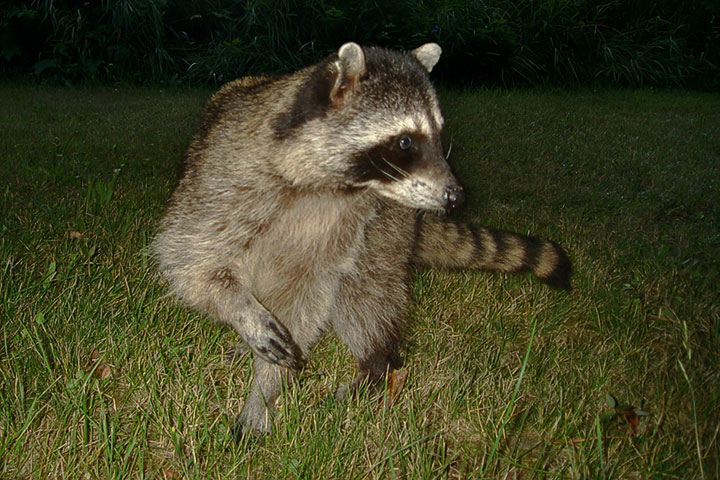 This raccoon is posed to pounce on something—probably a vole.
This raccoon is posed to pounce on something—probably a vole.
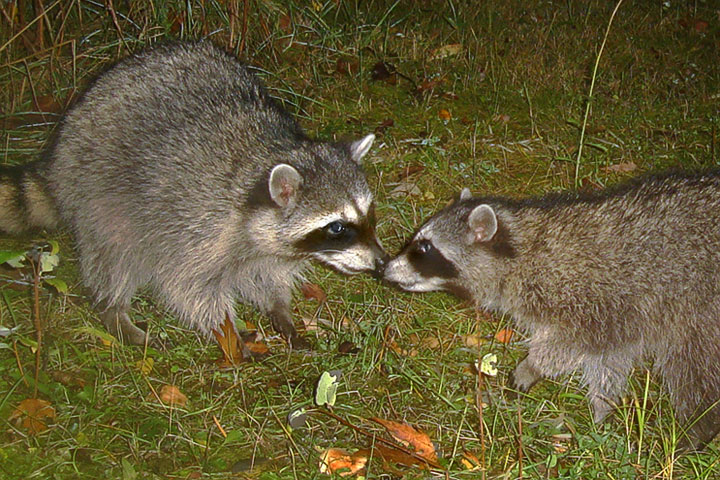 Having a nuzzle with a good friend.
Having a nuzzle with a good friend.
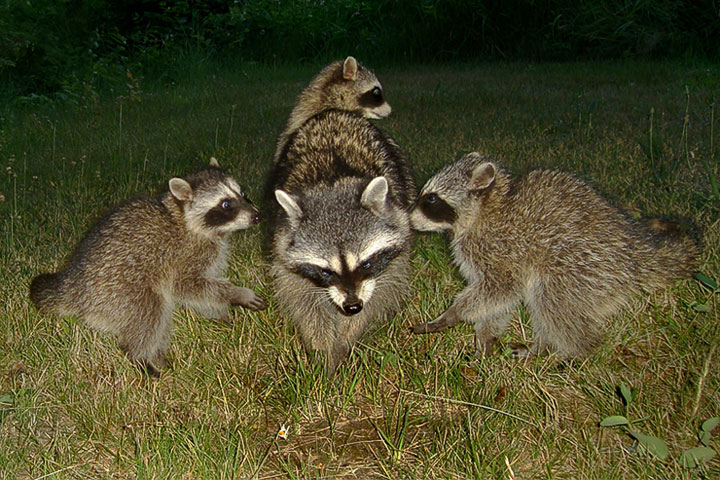 A mother and her three kits.
A mother and her three kits.
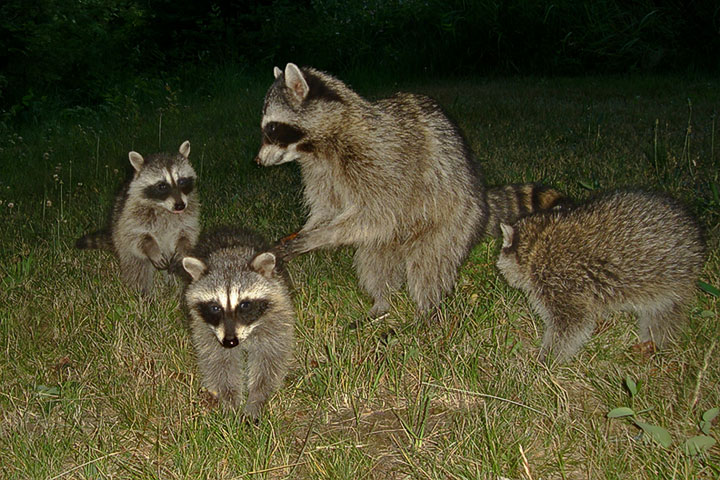 It looks as if the mother raccoon is instructing her kits on the art of foraging.
It looks as if the mother raccoon is instructing her kits on the art of foraging.
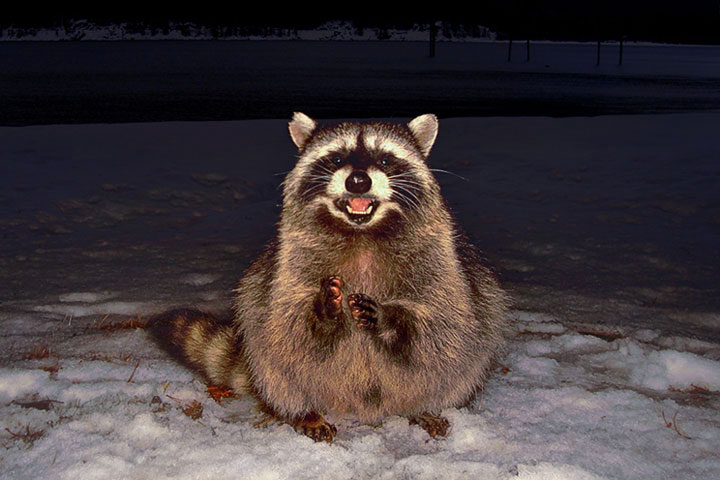 “I am taking a survey along the lakeshore about attitudes toward wildlife. (If I owned a phone, I would have called during dinner). Now, my first question: What are your thoughts on those pesky skunks?”
“I am taking a survey along the lakeshore about attitudes toward wildlife. (If I owned a phone, I would have called during dinner). Now, my first question: What are your thoughts on those pesky skunks?”
Information from Hinterland Who's Who: Raccoon (good but, the range map wrongly suggests that there are no raccoons here).
![]()